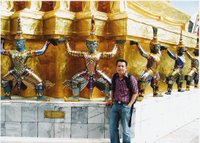Temple of the Emerald Buddha in Bangkok (2)
 Besides the Erawan Shrine in the Chitlom area, The Temple of the Emerald Buddha is probably the most photographed place in Bangkok. The Grand Palace is used today by the king for only certain ceremonial occasions such as Coronation Day and is closed to the public. The king's current residence is Chitlada Palace in the northern part of the city near the famous teak house, Viemanmek Mansion. Immediately upon entering Wat Phra Kaew, two gilded stupa as shown in the picture are built next to the Royal Pantheon in commemoration of King Rama I's parents. Directly across from the pantheon are eight prangs, or towers, dedicated respectively from the north to south to the important elements of Buddhism: the Buddha, the Dhamma (the law), The Sangha (the Buddhist monks), the Bhikshuni (Buddhist nuns who existed in the old days), Pacchekabodhi Buddhas (Buddhas who attained Enlightenment but never preached), the chakravarti (great emperors), the Bodhisattva (the Buddha in his previous lives) and the Maitreya (the future Buddha).
Besides the Erawan Shrine in the Chitlom area, The Temple of the Emerald Buddha is probably the most photographed place in Bangkok. The Grand Palace is used today by the king for only certain ceremonial occasions such as Coronation Day and is closed to the public. The king's current residence is Chitlada Palace in the northern part of the city near the famous teak house, Viemanmek Mansion. Immediately upon entering Wat Phra Kaew, two gilded stupa as shown in the picture are built next to the Royal Pantheon in commemoration of King Rama I's parents. Directly across from the pantheon are eight prangs, or towers, dedicated respectively from the north to south to the important elements of Buddhism: the Buddha, the Dhamma (the law), The Sangha (the Buddhist monks), the Bhikshuni (Buddhist nuns who existed in the old days), Pacchekabodhi Buddhas (Buddhas who attained Enlightenment but never preached), the chakravarti (great emperors), the Bodhisattva (the Buddha in his previous lives) and the Maitreya (the future Buddha). At the base of each of the two gilded stupas are demon and monkey caryatides.
At the base of each of the two gilded stupas are demon and monkey caryatides.  The king also had monuments erected for his ancestors and himself on the terrace of the Royal Pantheon. One will find emblems such as the upper part of a crown, a garuda holding a naga (snake), a pavilion, and bronze elephants.
The king also had monuments erected for his ancestors and himself on the terrace of the Royal Pantheon. One will find emblems such as the upper part of a crown, a garuda holding a naga (snake), a pavilion, and bronze elephants.A word of reminder. Bangkok's most heavily touristed areas, especially around Wat Phra Kaew, Wat Pho (Temple of the Reclining Buddha) and the Thas (piers), are favorite hunting grounds for con artists of every ilk. Sightseeing spots always attract flim-flam artists eyeing maptoting tourists. A man approached me and informed me that Wat Phra Kaew was closed for repairs. He then graciously suggested to arrange a tuk-tuk (motorized pedicab) ride to a wat that was Bangkok's best-kept secret. I kindly declined his offer with the confidence that the suggested itinerary was a sly guise for taking me somewhere to rip me off. Don't believe anyone on the street who tells you that a popular attraction is closed for a holiday; check for yourself. Another woman approached me and tried to tout these bags of bread crumbs to feed the pigeons at Sanam Luang (Royal Field). Don't ever accept such offer because you're very likely to end up losing a lot of money, like paying her 500 bacht for the crumbs.
2 Comments:
matt, you should work for a travel guide company! i'd like to sit with you and get some tips for my upcoming trip to Bangkok. Great writing.
Thanks Loren. Let's get together and plan out your Bangkok itinerary.
Post a Comment
<< Home